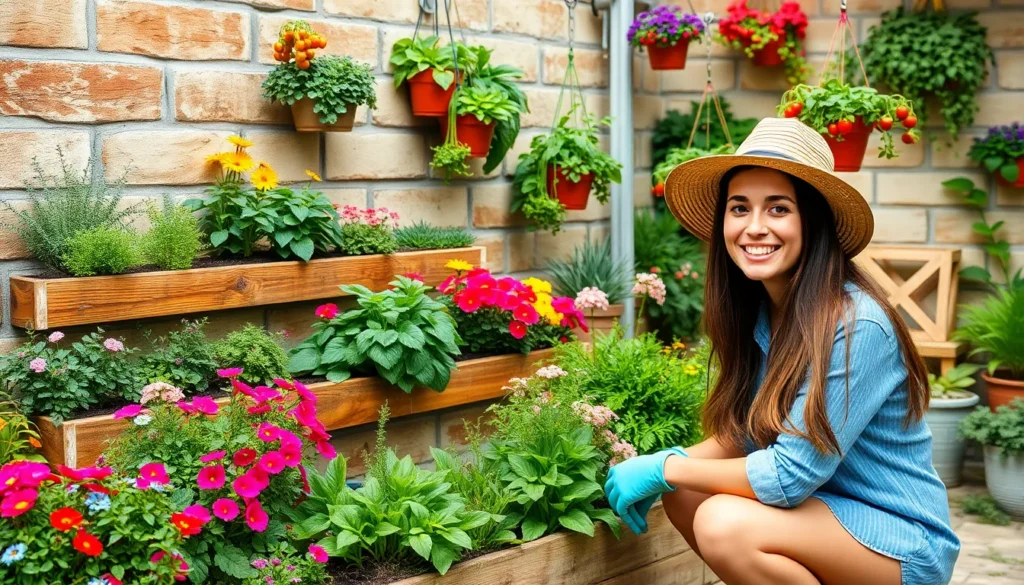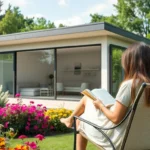Transform Your Tiny Outdoor Space Into a Garden Paradise
We’ve all been there – staring at that small patch of dirt behind our apartment or that narrow strip along our fence wondering if it’s even worth gardening. The truth is small spaces offer incredible opportunities for creative gardening that larger yards simply can’t match.
Whether you’re working with a tiny backyard a balcony or just a few square feet of soil we’ll show you how to maximize every inch. Small gardens aren’t limitations – they’re chances to get creative with vertical growing companion planting and space-saving techniques that’ll make your neighbors green with envy.
Ready to discover how a compact garden can deliver big results? We’re about to share game-changing ideas that prove size doesn’t matter when it comes to growing your own slice of paradise.
Maximize Vertical Space With Wall-Mounted Planters
Wall-mounted planters transform bare vertical surfaces into productive growing areas that double or triple your garden’s capacity. These innovative answers work particularly well in small spaces where ground area is precious.
Living Wall Systems for Herbs and Vegetables
Living wall systems create productive vertical gardens that deliver fresh herbs and vegetables right outside your kitchen door. We recommend modular pocket planters made from felt or fabric that hold multiple plants in a compact footprint. Popular herbs like basil, cilantro, parsley, and oregano thrive in these systems since they don’t require deep soil.
Lettuce varieties such as buttercrunch, romaine, and arugula grow exceptionally well in living walls due to their shallow root systems. Cherry tomatoes and peppers also adapt beautifully to vertical growing when you choose compact cultivars like ‘Tiny Tim’ or ‘Patio Princess’. Most living wall systems include built-in irrigation channels that distribute water evenly across all planting pockets.
Installation typically requires mounting a sturdy frame to your wall and connecting a simple drip watering system. We’ve found that south-facing walls provide optimal growing conditions for most edible plants in these systems.
Hanging Baskets for Trailing Plants
Hanging baskets maximize overhead space while adding layers of visual interest to your small garden design. Trailing plants like petunias, ivy geraniums, and bacopa cascade beautifully from elevated positions to create natural privacy screens. We suggest using coconut fiber lined baskets for better drainage and root aeration.
Strawberry varieties such as ‘Albion’ and ‘Seascape’ produce abundant fruit in hanging containers throughout the growing season. Trailing cherry tomatoes like ‘Tumbling Tom’ and ‘Balcony’ deliver impressive harvests from suspended planters. Mixed plantings combining trailing flowers with herbs create both beauty and functionality in compact spaces.
Sturdy mounting hardware becomes essential since saturated soil adds important weight to hanging displays. We recommend installing ceiling hooks rated for at least 50 pounds to ensure safe suspension of mature plantings.
Vertical Trellis Gardens for Climbing Vines
Vertical trellis systems support vigorous climbing plants that produce substantial harvests in minimal ground space. Pole beans, snap peas, and cucumbers naturally climb upward when provided with proper support structures. We prefer using sturdy metal or wooden trellises that extend 6 to 8 feet high for maximum growing potential.
Morning glories, clematis, and honeysuckle vines create stunning vertical displays while attracting beneficial pollinators to your small garden space. Edible climbers like hardy kiwi and grape vines establish productive growing systems that last for many years. Mesh panels or wire grids work effectively for lighter vines like sweet peas and nasturtiums.
Proper soil preparation at the base of trellises ensures strong root development for climbing plants. We recommend creating planting areas at least 12 inches wide and deep to accommodate the root systems of established climbing varieties.
Create Multi-Level Growing Areas With Raised Beds
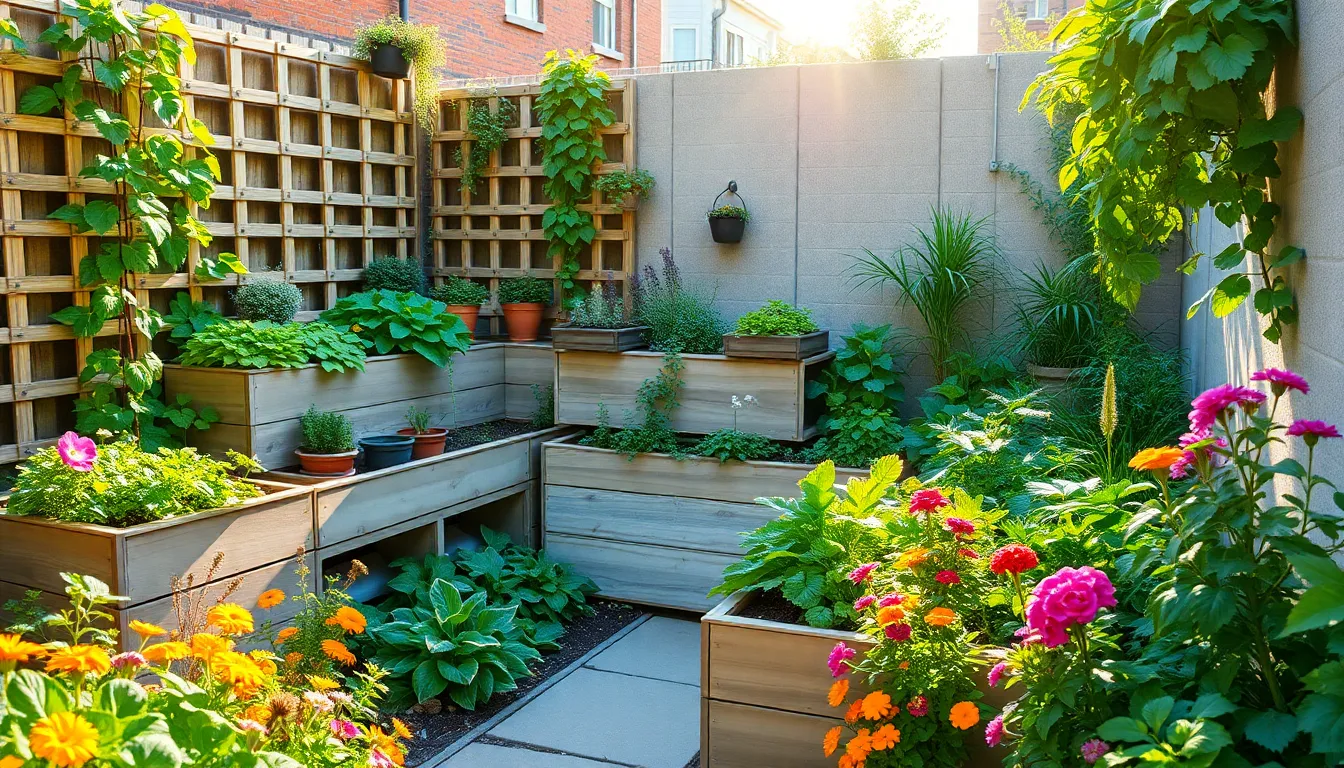
Building upward transforms small gardens into productive growing spaces that maximize every square inch. We’ll explore raised bed answers that create stunning multi-level gardens perfect for compact areas.
Tiered Planter Box Designs
Vertical gardening systems revolutionize how we approach small space cultivation by stacking growing areas at different heights. These tiered designs work exceptionally well on sloping terrain where traditional flat beds would waste valuable space. We can construct stepped planters using wood, stone, or composite materials that create distinct growing zones for different plant types.
Trellis integration amplifies our growing capacity by adding vertical support structures to each tier. Simple dowel or bamboo pole systems attached to raised beds accommodate climbing varieties like pole beans, peas, and cucumbers. Multi-level trellises create additional planting layers without expanding the garden’s footprint. Sturdy arbor systems can span multiple tiers while providing overhead growing space for vining crops.
Corner Raised Bed Answers
Corner planters transform overlooked spaces into productive growing areas that add visual interest to garden layouts. These L-shaped or triangular designs fit perfectly into corners where traditional rectangular beds won’t work effectively. We can build corner beds at varying heights to create ever-changing focal points that draw the eye upward while maximizing planting area.
Utilitarian corner designs combine growing space with practical features like built-in seating or storage compartments. Bench-style raised beds provide comfortable seating along garden edges while housing herbs or flowers beneath. Storage compartments integrated into corner beds keep tools and supplies easily accessible without cluttering the garden space.
Portable Container Garden Systems
Container mobility offers unmatched flexibility for small garden management and seasonal adjustments. Rolling planter boxes on casters allow us to relocate growing areas based on sun patterns, weather conditions, or space requirements. These portable systems work particularly well for renters who need garden answers they can take when moving.
Modular container arrangements create custom growing configurations that adapt to changing needs throughout the seasons. Stackable planters maximize vertical space while remaining easy to rearrange or transport. We can group containers of different sizes to create tiered effects that provide varied growing conditions for diverse plant types. Lightweight materials like resin or fiberglass make these systems manageable for frequent repositioning while maintaining durability for outdoor conditions.
Transform Unused Corners Into Productive Growing Spaces
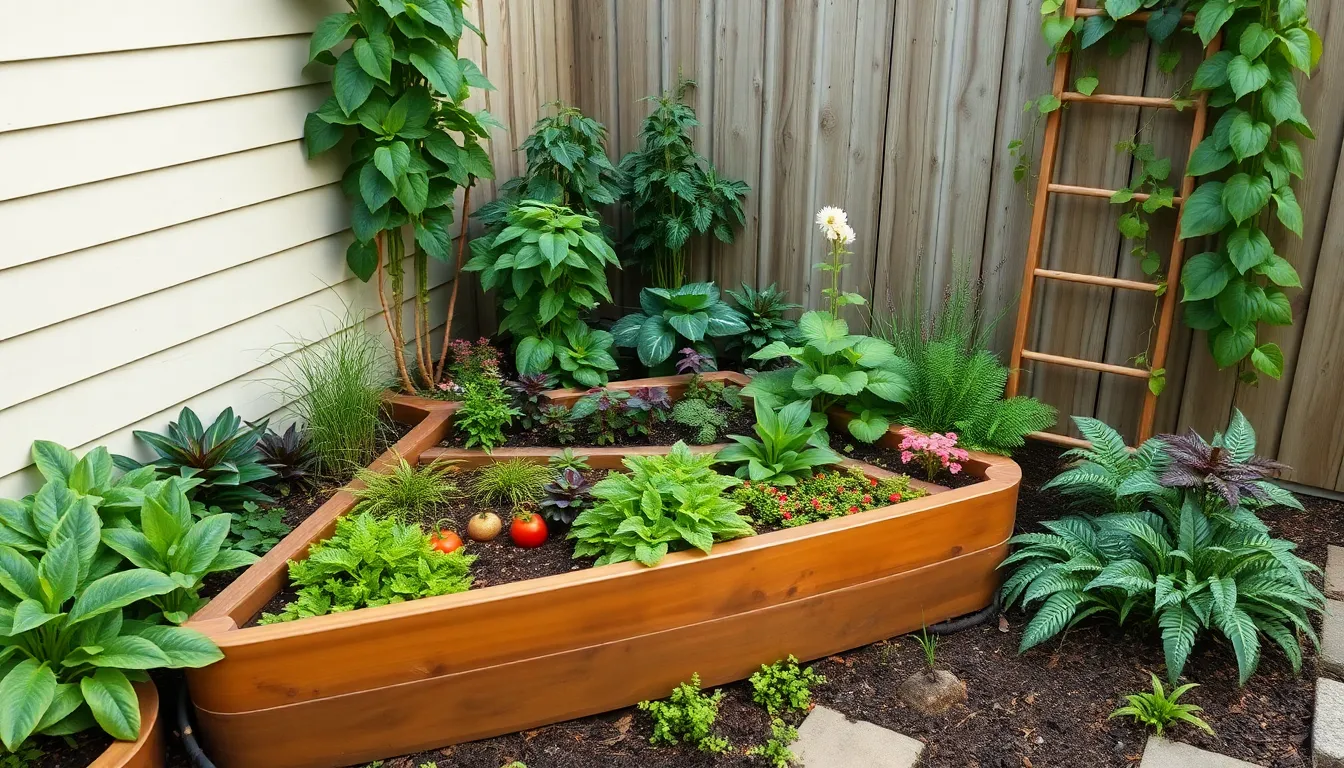
We’ve discovered that the most overlooked spaces in small gardens often hold the greatest potential for transformation. Every corner can become a thriving growing area with the right approach and plant selection.
Awkward Corner Vegetable Patches
Awkward corners present unique opportunities for creating dedicated vegetable growing zones that maximize every square foot. These spaces work exceptionally well with raised bed systems that provide better soil drainage and easier access for daily maintenance. Triangular raised beds fit perfectly into corner spaces and can accommodate compact vegetables like lettuce, radishes, and cherry tomatoes.
Container gardening offers another excellent solution for corner vegetable patches. Large containers and planters can be arranged in corner configurations to create productive growing areas without permanent ground modifications. This approach allows us to control soil quality completely while maintaining flexibility for seasonal changes.
Corner spaces also benefit from vertical growing techniques that extend the growing area upward. Trellises and support structures can be installed against walls or fences to support climbing vegetables like pole beans and cucumbers. This combination of ground level containers and vertical supports creates a highly productive corner garden system.
Shade-Tolerant Plant Arrangements
Shade tolerant plants like ferns, hostas, and heuchera thrive in corner areas that receive limited direct sunlight throughout the day. These plants create lush, textured displays that add visual interest to previously unused spaces. Layered planting arrangements work particularly well in these conditions, with taller plants providing backdrop and shorter varieties filling foreground areas.
Designing layered borders in shaded corners creates depth and visual appeal through varied heights and textures. We can arrange trees, shrubs, and perennials in graduated heights to maximize the impact of each plant while ensuring adequate light reaches all levels. This approach transforms dark corners into vibrant garden features.
Foliage plants excel in shaded corner arrangements where flowering plants might struggle. Varieties with different leaf shapes, sizes, and colors create compelling displays without relying on blooms. Mixing plants with broad leaves like hostas with fine textured ferns creates striking contrasts that enhance the overall design.
Microclimate Garden Nooks
Microclimate creation in corner spaces allows us to grow plants that might not otherwise thrive in our general garden conditions. Natural features like walls and large existing plants provide protection from wind and extreme temperatures while creating unique growing environments. These protected areas often maintain more consistent moisture levels and temperatures.
Installing focal points in corner microclimates enhances both visual appeal and functional benefits. Small water features like fountains or birdbaths create humidity that benefits surrounding plants while adding tranquil sounds to the garden space. These features also attract beneficial wildlife that supports overall garden health.
Structural elements can be added to corner spaces to enhance microclimate effects. Pergolas, arbors, or even simple lattice panels provide additional wind protection while creating vertical growing opportunities. These structures also serve as design elements that define the corner space as a distinct garden room within the larger industry.
Design Compact Theme Gardens for Visual Appeal
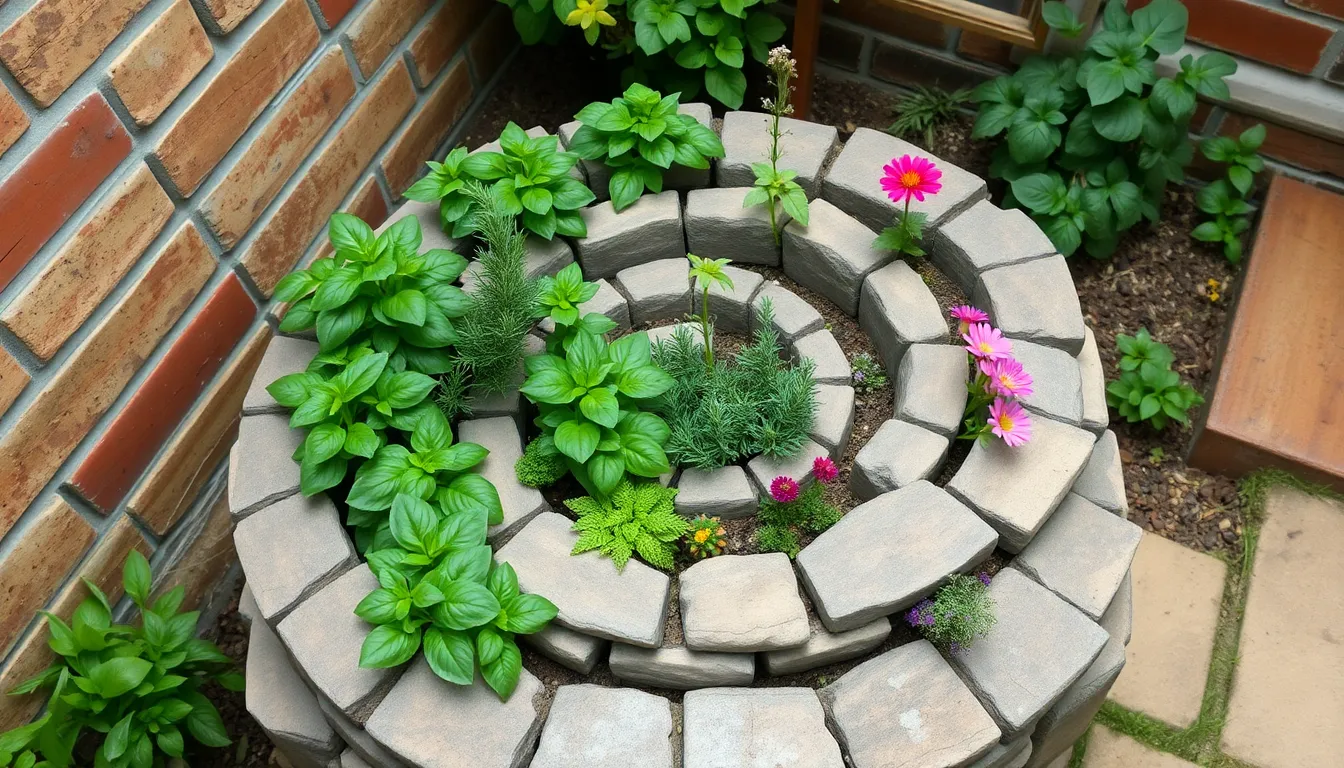
We can transform small spaces into stunning visual displays by utilizing strategic design principles and maximizing vertical growing opportunities. Theme-focused gardens create cohesive beauty while serving practical purposes in limited square footage.
Miniature Herb Spiral Gardens
Spiral herb gardens maximize growing space while creating an eye-catching focal point in compact areas. We design these gardens using a spiral pattern that incorporates herbs like basil, rosemary, and thyme, allowing different growing conditions within a small footprint. The elevated center provides excellent drainage for Mediterranean herbs, while the lower sections retain moisture for herbs requiring more water.
Creating the spiral structure requires careful planning to ensure each herb receives appropriate sunlight and growing conditions. We build these gardens using stones, bricks, or recycled materials, starting from the center and working outward in a gentle spiral. Regular pruning maintains the garden’s shape and promotes healthy growth throughout the growing season.
The spiral design naturally creates microclimates that accommodate different herb varieties in one compact space. We plant drought-tolerant herbs like lavender and oregano at the top, while moisture-loving herbs like parsley and chives thrive in the lower sections.
Small-Space Color Theme Plantings
Continuous color schemes across different garden levels create visual cohesion and make small spaces appear larger. We simplify our color palette by limiting variations to two or three colors, which maintains harmony and prevents overwhelming the space. This approach works particularly well when we carry the same colors from ground level plantings up through hanging baskets and wall planters.
Strategic lighting enhances our color themes by adding drama through backlighting plants, especially in covered or indoor growing areas. We position lights behind translucent foliage or colorful blooms to create stunning visual effects during evening hours. This technique transforms ordinary small gardens into captivating displays that extend enjoyment beyond daylight hours.
Monochromatic plantings using different shades of the same color family create sophisticated looks in compact spaces. We might choose various purple plants ranging from deep eggplant coleus to light lavender petunias, creating depth and interest without visual chaos.
Pocket-Sized Pollinator Gardens
Pollinator-friendly plant selections transform even the smallest garden corners into thriving ecosystems that attract bees and butterflies. We incorporate flowers like lavender, sunflowers, and zinnias in compact layouts using small planters or dedicated garden corners. These targeted plantings ensure diverse pollinator activity while requiring minimal space commitment.
Container arrangements work exceptionally well for pocket pollinator gardens since we can position them strategically to maximize sun exposure and visual impact. We choose native flowering plants that bloom at different times throughout the season, providing consistent nectar sources for beneficial insects. This approach creates sustainable mini habitats that support local ecosystems.
Vertical pollinator gardens use wall space and hanging planters to accommodate more flowering varieties in tight quarters. We employ climbers like roses or flowering vines to soften harsh visual barriers while providing additional pollinator resources. These living walls create stunning backdrops while serving essential ecological functions in our compact garden designs.
Utilize Container Gardening for Flexibility and Control
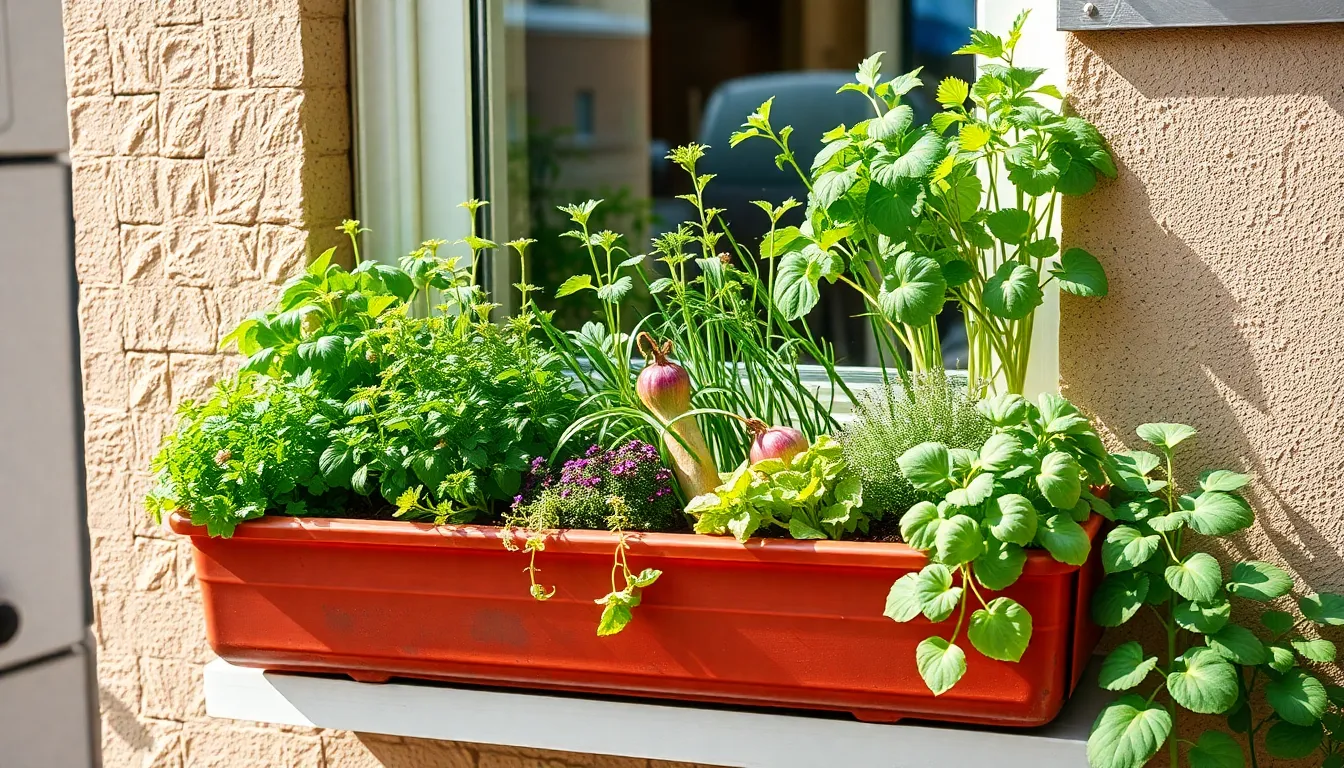
Container gardens offer unmatched versatility for small space gardening, allowing us to place plants anywhere with adequate light including windowsills, balconies, and rooftops. We’ll reduce weed and pest issues significantly while maintaining complete control over soil quality and plant placement.
Window Box Vegetable Gardens
Window boxes maximize space efficiency by transforming any window into a productive growing area. We can grow herbs like basil, thyme, and rosemary alongside compact vegetables such as cherry tomatoes and lettuce right outside our windows. Easy access makes watering and harvesting simple, while the elevated position provides excellent drainage and sunlight exposure. These systems work perfectly for beginners since they require minimal setup and offer immediate visual feedback on plant health.
Repurposed Container Ideas
Creative container choices help us build budget friendly gardens using items we already own. Old boots, tubs, and wooden crates become unique planters when we add proper drainage holes to prevent waterlogging. Recycled materials like plastic storage bins, metal buckets, and ceramic pots work equally well for growing vegetables and herbs. This approach saves money while reducing waste, making our small garden both environmentally conscious and cost effective.
Mobile Planter Answers
Mobile planters give us complete flexibility to optimize growing conditions throughout the day and seasons. We can move containers to follow sunlight patterns or protect plants from harsh weather conditions like strong winds or excessive rain. Wheeled planters and lightweight containers work best for small balconies and patios where space changes based on our daily activities. This portability allows us to experiment with different plant arrangements and create seasonal displays that keep our small garden interesting year round.
Incorporate Space-Saving Plant Varieties
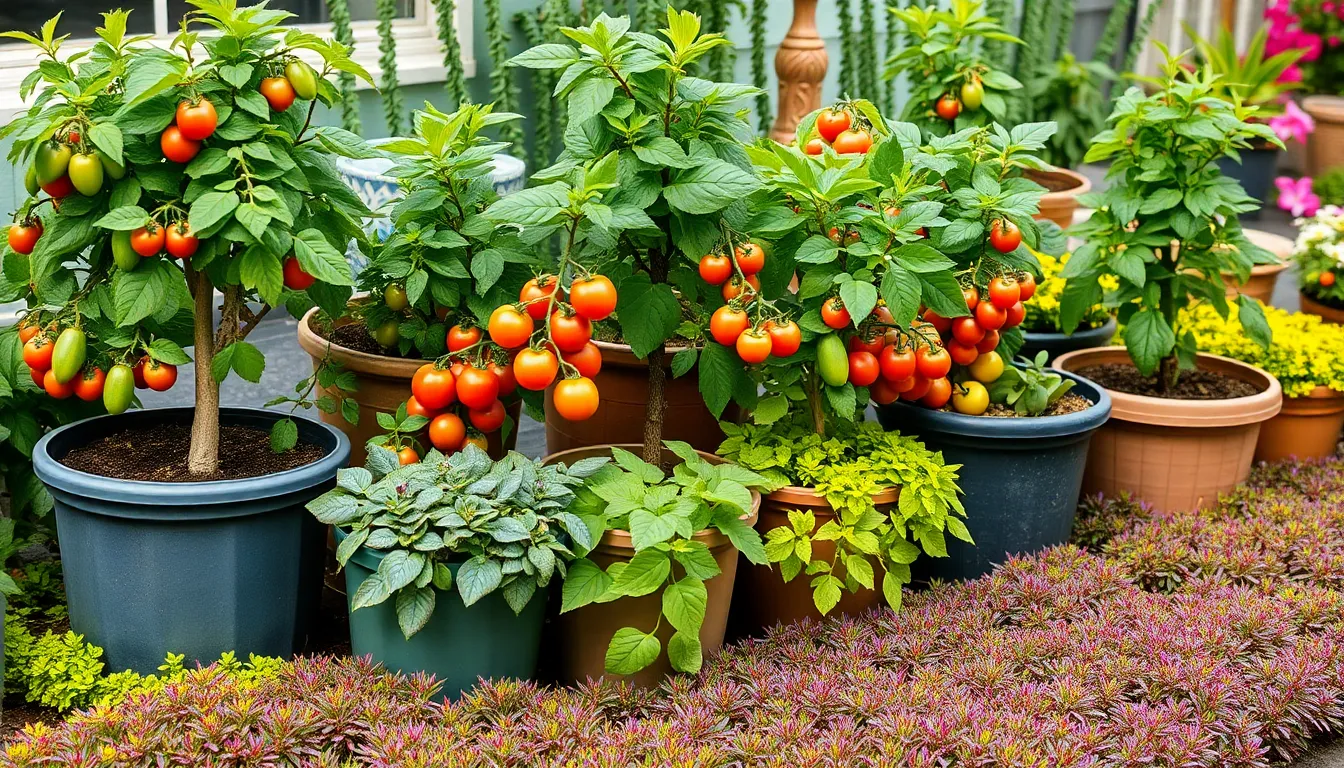
When working with limited growing areas, selecting the right plant varieties can dramatically increase our garden’s productivity. Smart plant choices allow us to maximize every square foot while still enjoying abundant harvests and beautiful foliage.
Dwarf Fruit Tree Options
Dwarf fruit trees offer the perfect solution for small garden spaces without sacrificing delicious homegrown produce. These compact varieties typically reach only 6-8 feet in height compared to standard trees that can tower at 20-30 feet, making them ideal for patios, small yards, and container growing.
Dwarf apple trees produce full-sized fruit on manageable trees that we can easily harvest and maintain. Popular varieties like ‘Honeycrisp’ and ‘Gala’ thrive in containers and require minimal pruning to keep their compact shape.
Cherry tree varieties in dwarf form bring beautiful spring blossoms followed by sweet fruit throughout summer. ‘Stella’ and ‘Compact Lambert’ varieties are self-pollinating, meaning we don’t need multiple trees for fruit production.
Peach trees in dwarf varieties like ‘Bonfire’ and ‘Red Baron’ offer juicy stone fruits from trees that stay under 6 feet tall. These varieties often produce fruit within 2-3 years of planting, providing quick rewards for our gardening efforts.
Compact Vegetable Cultivars
Selecting space-efficient vegetable varieties ensures we get maximum yield from minimal growing space. Modern breeding has created many compact cultivars specifically designed for small garden success.
‘Red Robin’ tomatoes are perfect cherry tomato plants that grow only 12 inches tall but produce abundant clusters of sweet, bite-sized fruit. These determinate varieties work excellently in hanging baskets or small containers on patios.
‘Patio’ cucumbers were bred specifically for container growing and produce full-sized cucumbers on compact vines. These bush varieties eliminate the need for extensive trellising while still providing crisp, fresh cucumbers throughout the growing season.
‘Thumbelina’ carrots grow to just 2 inches long, making them perfect for shallow containers and raised beds with limited soil depth. These round, sweet carrots mature quickly and can be succession planted for continuous harvests.
Compact lettuce varieties like ‘Tom Thumb’ and ‘Little Gem’ form small, dense heads perfect for single servings. These space-efficient greens allow us to grow multiple varieties in the same area where one full-sized head would typically grow.
Ground Cover Plants That Maximize Coverage
Ground cover plants serve dual purposes in small gardens by suppressing weeds while creating lush, continuous coverage that makes spaces appear larger and more unified.
Creeping thyme spreads rapidly to fill gaps between stepping stones and pavers while releasing a delightful fragrance when walked upon. This hardy perennial requires minimal maintenance and produces small purple flowers that attract beneficial pollinators to our garden space.
Creeping Jenny’s golden foliage brightens shaded areas and quickly covers large sections of ground with its trailing stems. This versatile plant thrives in damp conditions where other ground covers might struggle, making it perfect for areas with poor drainage.
Vinca minor, commonly known as periwinkle, provides year-round evergreen coverage that effectively shades out competing weeds. Its glossy leaves and occasional purple blooms create an elegant carpet that requires minimal care once established.
Ajuga forms dense mats of colorful foliage topped with spikes of blue flowers in spring. This low-maintenance ground cover works well under trees and in other challenging areas where grass won’t grow, providing consistent coverage throughout the seasons.
Add Functional Elements That Save Space
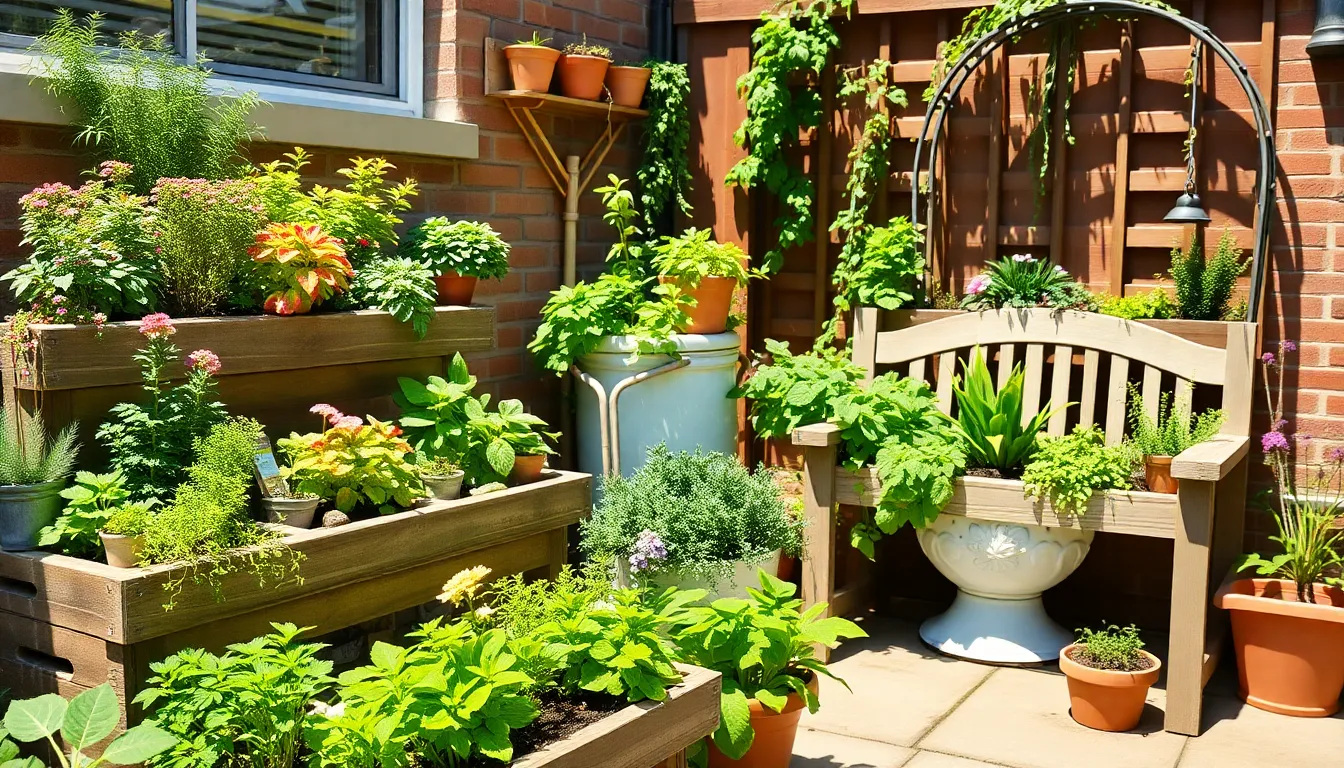
Smart functional elements can transform our small gardens into highly efficient spaces that serve multiple purposes. We’ll maximize every square inch by incorporating storage answers, versatile plant supports, and adaptable furniture.
Garden Storage Integration
Seating with storage becomes our dual-purpose solution that keeps essential gardening tools organized while providing comfortable spots to rest. We recommend storage benches that conceal hand tools, gloves, and small watering equipment underneath weatherproof cushioned tops. These multipurpose pieces eliminate clutter and create clean sightlines throughout our compact gardens.
Repurposed containers offer creative storage alternatives that add character while maximizing functionality. We can transform old colanders into unique planters that provide excellent drainage for herbs like oregano and sage. Vinyl gutters mounted along fence lines create linear growing systems perfect for shallow-rooted plants such as lettuce and spinach varieties.
Built-in storage answers integrate seamlessly with raised bed designs to keep supplies within arm’s reach. We suggest incorporating tool storage compartments directly into planter box corners, creating designated spaces for trowels, pruning shears, and plant markers. These integrated systems maintain our garden’s organized appearance while ensuring quick access to frequently used items.
Multi-Purpose Plant Supports
Arched trellises serve as both structural elements and growing supports that guide climbing plants upward while creating natural garden divisions. We position these supports to accommodate vigorous climbers like English ivy and climbing roses, which transform bare vertical surfaces into living walls. These curved structures add architectural interest while maximizing our growing capacity in minimal ground space.
Tiered planters create cascading displays that use vertical space efficiently while supporting plants with varying height requirements. We arrange these stepped systems to accommodate trailing herbs like thyme and oregano on upper levels, with taller vegetables such as cherry tomatoes anchored in lower tiers. This arrangement ensures optimal sunlight distribution for each plant while creating visually ever-changing growing areas.
Living support structures combine plant supports with functional garden elements like privacy screens and wind barriers. We install sturdy post and wire systems that support heavy producers like pole beans and climbing cucumbers while simultaneously defining garden boundaries. These dual-purpose installations maximize productivity while addressing practical needs for shelter and privacy.
Fold-Away Garden Furniture
Foldable chairs provide comfortable seating options that disappear completely when we need maximum space for gardening activities. We choose lightweight aluminum or weather-resistant wood designs that stack compactly against walls or inside storage areas. These portable seating answers allow us to enjoy our gardens without permanently sacrificing precious growing space.
Multi-functional furniture serves as workspaces, storage units, and seating areas depending on our immediate needs. We select folding tables that transform into potting benches during planting season and convert to dining surfaces for outdoor meals. These versatile pieces adapt to our changing activities while maintaining our garden’s uncluttered appearance.
Collapsible work stations create temporary preparation areas that support our gardening tasks without occupying permanent space. We use portable potting benches with fold-down shelves that provide organized workspaces for transplanting seedlings and preparing plant containers. These mobile stations store flat against walls when not needed, preserving our limited garden area for growing activities.
Extend Growing Seasons With Smart Planning
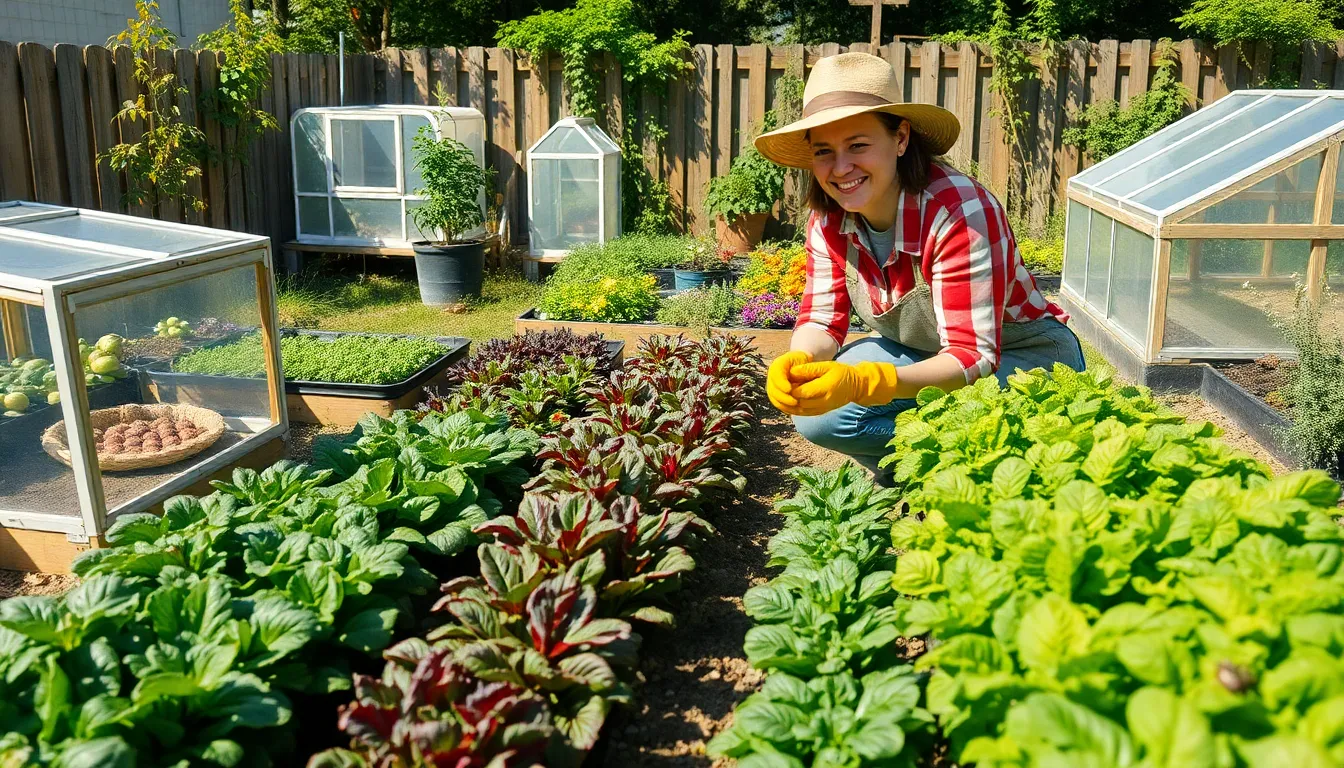
Smart timing and strategic planning transform small gardens into year-round productive spaces. We can significantly increase our harvest by understanding local frost dates and implementing proven season extension techniques.
Succession Planting Techniques
Succession planting maximizes our small garden’s productivity by ensuring continuous harvests throughout the growing season. We plant small amounts of crops like beets every 2-3 weeks through mid-summer to create staggered harvests that prevent overwhelming abundance or disappointing gaps.
Most vegetables and herbs respond well to succession planting, though we should check exact crop requirements for optimal replanting frequency. Leafy greens like lettuce and spinach work exceptionally well with this method, as do radishes and carrots. We maintain a garden journal to track planting dates and varieties, which helps us refine our timing for future seasons.
Sequential sowings work particularly well in container gardens where we can easily replace harvested plants with new seedlings. We can dedicate exact containers to succession crops, rotating plantings every few weeks to maintain consistent production in our limited space.
Cold Frame and Mini Greenhouse Ideas
Cold frames and mini greenhouses create protective microclimates that extend our growing season in small spaces without requiring permanent structures. We can construct simple cold frames from recycled windows or clear plastic supported by wooden or metal frames, making them perfect for temporary season extension.
Mini greenhouses offer flexibility for small garden owners who need portable protection options. Clear storage bins work as improvised greenhouses for starting seeds or protecting tender plants, while small purchased structures provide more professional results. Both options trap heat effectively and create suitable conditions for tender plants or early seed starting.
These protective structures work especially well in corner spaces or against south-facing walls where they capture maximum sunlight. We position them strategically to take advantage of reflected heat from nearby surfaces, amplifying their warming effect in our compact growing areas.
Year-Round Growing Strategies
Year-round growing combines multiple techniques to maintain continuous harvests even in small spaces throughout all seasons. We employ succession planting alongside cold frames and mini greenhouses to create a comprehensive growing system that adapts to changing weather conditions.
Cold-hardy crops thrive in protected structures during winter months, allowing us to harvest fresh greens when outdoor gardens lie dormant. We use indoor lighting for microgreens or herbs, bringing production inside when outdoor conditions become too harsh. Fast-maturing and cold-tolerant varieties maximize our yield across seasons while requiring minimal space.
Crop rotation and planned growing blocks help us manage labor efficiently while maintaining continuous production in our limited garden area. We select varieties with different maturity dates that fit our available growing windows, adjusting seeding and transplanting schedules to maximize productivity. Row covers and mulches serve as additional season extenders, protecting our plants while conserving valuable growing space.
Conclusion
We’ve shown you that small gardens aren’t limitations—they’re opportunities to get creative and maximize every inch of your outdoor space. With the right combination of vertical growing techniques container systems and space-saving plant varieties you can create a productive garden that rivals much larger spaces.
The key lies in thinking beyond traditional gardening methods. Whether you’re utilizing corner spaces building multi-level growing areas or incorporating functional storage answers these strategies help you make the most of what you have.
Your small garden journey starts with choosing techniques that match your space and goals. Remember that even the tiniest outdoor area can become a thriving green sanctuary when you apply smart planning and innovative design principles we’ve shared.
Frequently Asked Questions
What are the main advantages of small gardens?
Small gardens offer unique advantages including easier maintenance, creative design opportunities, and the ability to maximize every square inch. They allow for focused attention on plant care, encourage vertical growing techniques, and can be more productive per square foot than larger spaces. Small gardens also reduce water usage and are perfect for experimenting with companion planting and space-saving methods.
How can I use vertical space in my small garden?
Maximize vertical space with wall-mounted planters, living wall systems, and hanging baskets. Install trellises for climbing plants like beans and cucumbers, use modular pocket planters for herbs, and create tiered growing systems. Vertical gardening effectively doubles or triples your growing capacity while adding visual interest to walls and fences.
What plants work best in containers for small spaces?
Choose compact varieties like ‘Patio’ cucumbers, ‘Red Robin’ tomatoes, and dwarf fruit trees. Herbs like basil, lettuce varieties, and trailing plants such as strawberries and cherry tomatoes thrive in containers. Look for plants specifically bred for small spaces, as they’re designed to produce well in limited root space.
How do I create a productive corner garden?
Transform corners using triangular raised beds, vertical trellises, and container arrangements. Choose shade-tolerant plants if the corner receives limited sunlight, and create layered planting for visual interest. Consider the microclimate conditions and add focal points like small water features to enhance both function and aesthetics.
What are succession planting techniques?
Succession planting involves sowing small amounts of crops at regular intervals (typically 1-3 weeks apart) to ensure continuous harvests throughout the growing season. This prevents overwhelming harvests and gaps in production, making it perfect for small gardens where space is limited but consistent yield is desired.
How can I extend my growing season in a small garden?
Use cold frames, mini greenhouses, and row covers to create protective microclimates. These structures can be built from recycled materials and help maintain growing conditions year-round. Combine with succession planting, proper mulching, and strategic crop rotation to maximize your small garden’s productivity across seasons.
What storage solutions work best for small gardens?
Incorporate multi-functional furniture like benches with built-in storage, use repurposed containers as planters, and integrate storage compartments within raised beds. Fold-away furniture and collapsible workstations help maintain clean, organized spaces while keeping essential gardening tools accessible without cluttering your limited area.
How do I choose the right containers for my plants?
Select containers based on plant root depth requirements and drainage needs. Window boxes work well for herbs and compact vegetables, while deeper containers suit tomatoes and peppers. Ensure all containers have drainage holes, and consider mobility if you need to move plants for optimal sun exposure.

